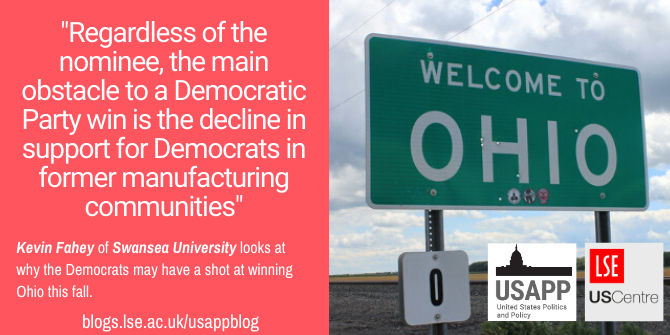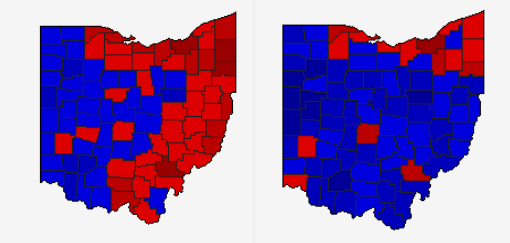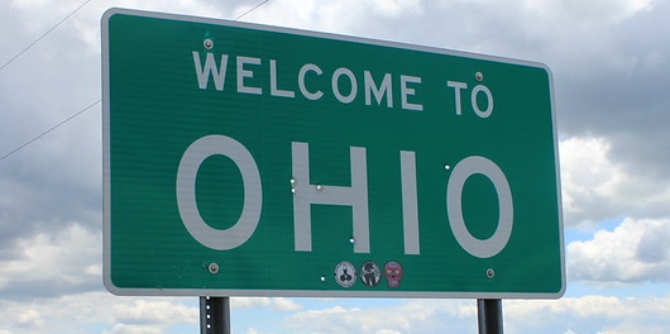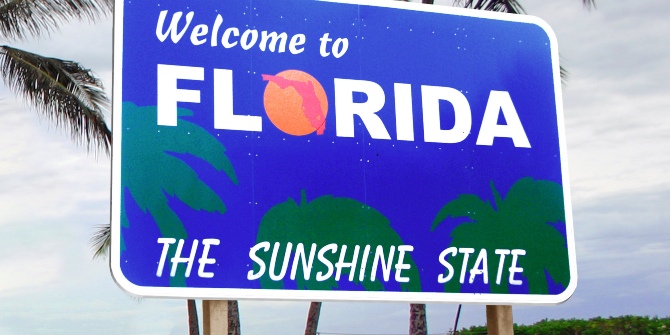 While Ohio has historically been considered to be a swing state, in the 2016 election, The Buckeye State went against the national trend and voted for Donald Trump. Kevin Fahey takes a close look at how the presidential election may unfold in Ohio, writing that because of the potential impact of COVID-19 on the economy, and the likelihood of Former Vice President Joe Biden being the nominee, the contest may well be closer than we think.
While Ohio has historically been considered to be a swing state, in the 2016 election, The Buckeye State went against the national trend and voted for Donald Trump. Kevin Fahey takes a close look at how the presidential election may unfold in Ohio, writing that because of the potential impact of COVID-19 on the economy, and the likelihood of Former Vice President Joe Biden being the nominee, the contest may well be closer than we think.
- This article is part of our Primary Primers series curated by Rob Ledger (Frankfurt Goethe University) and Peter Finn (Kingston University). Ahead of the 2020 election, this series explores key themes, ideas, concepts, procedures and events that shape, affect and define the US presidential primary process. If you are interested in contributing to the series contact Rob Ledger (ledger@em.uni-frankfurt.de) or Peter Finn (p.finn@kingston.ac.uk).
It is an oft-repeated observation that no Republican has ever won the Presidency without Ohio. No state is more critical to the fortunes of the Republican Party than Ohio. And in many ways, The Buckeye State is a natural fit for Donald Trump’s new Republican coalition: whites without college degrees, rural voters, and wealthy residents of city fringes. Yet there are also reasons to suspect that likely Democratic nominee Joe Biden could win the state handily. Ohio may turn out to be a surprising battleground in the 2020 elections.
First, we must contend with the fact that Ohio is no longer a swing state. Despite losing the popular vote nationally in 2016, President Trump won Ohio by eight percentage points. The decline of many manufacturing industries over the past forty years, coupled with an exodus of Ohioans to Sun Belt states like Florida and Texas, remade the state’s electorate into one that gives the current Republican coalition a decided advantage. Ohio’s loss of 8 of 26 (leaving them with 18 today) seats in the House of Representatives over the past forty years has resulted in the state having far less influence in Congress and in selecting the President. This decline has led many Ohioans to feel legitimately aggrieved that Washington D.C. does little for their interests, an opportunity that President Trump took advantage of in 2016.
Ohio is also crippled by an education gap; only 27 percent of its citizens have bachelor’s degrees. This is very good news for President Trump, who won every state with less than 30 percent BA-earned citizens (save New Mexico and Nevada, whose large numbers of minority voters helped elect Democrats). Despite a 40-seat pickup in the House of Representatives, Democrats could not topple two vulnerable Ohio Republicans (Steve Chabot, R-Cincinnati, and Troy Balderson, R-Zanesville) – neither of those seats are likely to be competitive in the 2020 election cycle either. These factors would lead one to think that Ohio will be reliably Republican for some time to come, more like its neighbor Indiana and less like nearby Pennsylvania and Michigan.
But Republican fortunes in the state are no guarantee. Since 2000 – the current period of partisan polarization – the Republican Party has received 49.3 percent of the vote, averaging approximately 2,678,200 votes. By contrast, Democrats have obtained 48.1 percent of the vote, averaging approximately 2,617,800 votes. The Republican Party has an advantage, but not an overwhelming one – in a wave election, Democrats should expect to win Ohio as well. Second, the Republican Party of Donald Trump is not as ascendant in the state as one would expect. In 2016, Donald Trump won 18,762 fewer Ohioans’ votes than George Bush in 2004. Indeed, despite Ohio’s population growing by 300,000 people between 2004 and 2016, 300,000 fewer voters turned out to vote for any candidate in Trump’s 8-point win than in Bush’s 2-point win in 2004. In short, Republicans can win Ohio, but they require several factors to break their way.

“Welcome to Ohio” by astronomy_blog is licensed under CC BY NC SA 2.0.
Chief among these factors is the economy. Countless pages of ink have been spilled writing about the economic effect of novel COVID-19, the coronavirus that originated in Wuhan province, China and has now spread all over the world. While some remain skeptical that the virus will have the same fatal consequences as the 1918-1919 influenza pandemic – or even the 2009 influenza pandemic which killed as many as 500,000 people – markets show indications that a new recession is imminent. Stock market indices have plunged nearly 20%, and growth forecasts have been revised to show low growth or even contraction. Dramatic NASA satellite photos of air pollution over China (below) show the precipitous drop in manufacturing output, which will have cascading effects on the economy – and on President Trump’s re-election prospects.
Figure 1 – Airborne Nitrogen Dioxide Plummets Over China

Credit: NASA’s Earth Observatory
If the coronavirus spread continues to adversely harm markets, it is also likely to hurt President Trump’s standing among Ohioans and open the door for a Democratic win.
Second, Republicans are going to need Donald Trump to avoid the sorts of unforced errors that have categorized his Presidency. According to a time series of Ohio public opinion run by the Morning Consult polling firm, Trump’s disapproval rate in Ohio increased to over 50 percent following the Charlottesville attack, various eruptions of the Stormy Daniels/Michael Cohen scandal throughout 2018, and the government shutdown in December 2018-January 2019. Trump’s proclivity for engaging in unpopular behavior may provide an opening for the right kind of Democratic candidate.
Of the Democratic candidates remaining, probable – but by no means guaranteed – nominee Joe Biden is likely the one best-situated to win Ohio. He grew up in the adjacent Rust Belt state of Pennsylvania, prioritizes economic regeneration popular amongst Ohioans, and campaigned there extensively during his eight years as Vice President. Six general-election matchup polls between Biden and President Trump show Biden winning Ohio by a 6-point margin. By contrast, Biden’s Democratic primary colleague Bernie Sanders only defeats Trump by an average of 2 points, according to those same six polls.
Before Biden can begin to contest Trump for the Presidency, he must win against Bernie Sanders, who is likely to fight for the nomination to and through the convention. Sanders is very popular with young voters, Latinx voters, and city-dwellers, which are a sufficiently large proportion of the Ohio Democratic primary electorate to make the state competitive (although, ironically, in the 2016 campaign, Sanders only won rural Ohio counties and Athens county, where Ohio University is located). If Biden can best Sanders in places like Ohio by sufficient margins, then he can clinch the nomination before the convention and pivot to the general election.
Regardless of the nominee, the main obstacle to a Democratic Party win is the decline in support for Democrats in former manufacturing communities. Figure 2 shows Democratic Senator Sherrod Brown (D-Mansfield)’s electoral wins in 2006 (Left, 56 percent statewide vote share) and 2018 (Right, 53 percent statewide vote share). Democrats for decades relied on winning Ohio through the so-called “inverted C,” consisting of the Toledo-Cleveland-Akron metropolitan areas, the parts of the state bordering Pennsylvania and West Virginia to the East, and the capital of Columbus. Today, Democrats win the urban counties and precious little else.
Figure 2 – 2006 and 2018 state-wide vote

Credit: Dave Leip’s Election Atlas
To be successful, Democrats need to win urban areas by large margins, and limit losses in the rest of the state as much as possible. While it is possible, it requires a substantial investment of campaign staff, a large volunteer-driven campaign, and may require an unpopular incumbent Republican and/or a faltering economy.
Given the reliance on outside factors – the coronavirus, the economy, President Trump – should Democrats invest the required resources to win the state? As Pennsylvania, Michigan, and Wisconsin (or Florida and Arizona) provide two easier alternate pathways to victory, Democrats may be better off focusing on these alternate routes to victory. Investments in North Carolina and Georgia, two growing states with similar numbers of electoral votes, may also prove more worthwhile in the long run.
There are reasons for Democrats to keep Ohio competitive in 2020. First, former Democratic candidate Michael Bloomberg has pledged to spend unprecedented sums in support of the Democratic nominee, meaning resources may not be a constraint. Second, if Democrats can make the state competitive, Republicans will have to spend resources there that they could have spent elsewhere. Third, an Ohio-plus Midwest path exists for the right candidate – if the Democrats can select that candidate, they could win the Rust Belt states they lost in 2016. By contrast, without the right candidate, President Trump is likely to win the state and its 18 electoral votes, placing him that much closer to winning re-election.
- Note: A few hours after this article was published, the coronavirus was labeled a pandemic by the WHO.
Please read our comments policy before commenting.
Note: This article gives the views of the author, and not the position of USAPP – American Politics and Policy, nor of the London School of Economics.
Shortened URL for this post: http://bit.ly/3cHUcFU
About the author
 Kevin Fahey – Swansea University
Kevin Fahey – Swansea University
Kevin Fahey is a Lecturer in Politics in the Department of Political & Cultural Studies at Swansea University. He studies study political institutions and elite behavior, with specialization in subnational politics.






